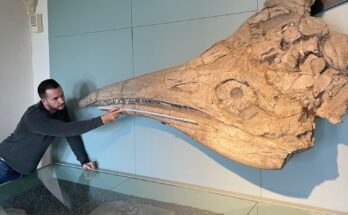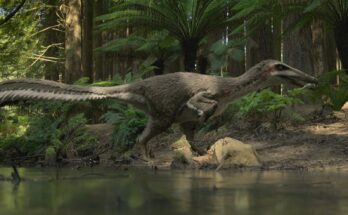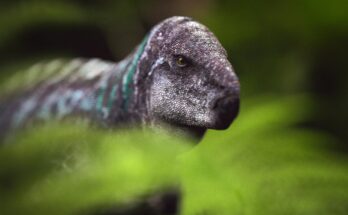Introduction
The Triceratops is one of the most iconic dinosaurs that ever lived. With its three formidable horns, massive frilled skull, and sturdy, tank-like body, it was a dominant herbivore of the Late Cretaceous period. But how much do we really know about this prehistoric giant?
Chapter 1: Discovery & Naming—How Triceratops Was Found
The First Fossils (1887-1889)
The first Triceratops bones were discovered in Denver, Colorado (1887), but paleontologist Othniel Charles Marsh initially thought they belonged to a giant bison! A year later, more fossils in Wyoming confirmed it was a dinosaur.
Marsh named it “Triceratops horridus” (meaning “three-horned face”) in 1889, and since then, hundreds of fossils have been found across North America (Montana, South Dakota, Canada).
Fossil Hotspots & Key Finds
- Hell Creek Formation (Montana, USA) – One of the richest Triceratops fossil sites.
- Scollard Formation (Alberta, Canada) – Proves Triceratops lived in cooler climates.
- “Cliff the Triceratops” (2014) – A nearly complete skeleton sold for $7.7 million!
Fun Fact: Some early scientists debated whether Triceratops was a dinosaur or a prehistoric rhino!

Chapter 2: What Did Triceratops Look Like?
Size & Weight
- Length: Up to 30 feet (9 meters)—as long as a school bus!
- Height: 9-10 feet (3 meters) at the shoulder.
- Weight: 6-12 tons—heavier than an African elephant!
The Famous Horns & Frill
- Three Horns: Two long brow horns (up to 3 feet) and a shorter nose horn.
- Bone Frill: A giant shield-like structure made of solid bone—possibly for defense, display, or temperature control.
- Did They Change with Age? Juvenile Triceratops had curved horns, while adults had straight, forward-facing ones.
Myth Buster: Some old drawings show Triceratops with floppy frills (like a lizard’s flap), but fossils prove it was solid bone!

Chapter 3: How Did Triceratops Live?
Diet: The Ultimate Cretaceous Grazer
Triceratops was a plant-eater (herbivore) with:
✔ A beak-like mouth for snipping tough plants.
✔ Cheek teeth for grinding ferns, cycads, and palms.
✔ A huge gut to digest fibrous vegetation.
Fun Fact: Some scientists think Triceratops knocked down trees like a modern elephant!
Behavior: Herds or Lone Wanderers?
- Possible Herding: Bonebeds with multiple Triceratops suggest they traveled in groups (like buffalo).
- Fighting for Dominance? Broken horns and frill injuries hint at head-butting battles (like rams).
Predators: Battling T. rex
Triceratops was a prime target for Tyrannosaurus rex—fossil evidence shows bite marks on frills and even healed wounds, meaning some survived attacks!
Epic Dino Fight? A famous fossil (nicknamed “The Dueling Dinosaurs”) shows a T. rex and Triceratops locked in combat—possibly killing each other!

Chapter 4: Why Did Triceratops Go Extinct?
The Cretaceous-Paleogene (K-Pg) Extinction
About 66 million years ago, a massive asteroid struck Earth (Chicxulub, Mexico), causing:
🌋 Volcanic eruptions
🌊 Tsunamis
❄ “Nuclear winter” from dust blocking sunlight
Triceratops, along with all non-avian dinosaurs, couldn’t survive the climate collapse.
Did Any Relatives Survive?
- Birds are the only living dinosaurs (but no horned ones!).
- Modern rhinos fill a similar ecological role but aren’t closely related.

Chapter 5: Triceratops in Pop Culture & Science
Movies & Media
- “Jurassic Park” (1993) – Featured in the famous T. rex chase scene.
- Documentaries – BBC’s “Walking with Dinosaurs” portrayed its life.
Ongoing Research
- Was Triceratops a juvenile Torosaurus? Some scientists debate if they’re the same species at different growth stages.
- New Horn Discoveries – Recent studies suggest horns may have been covered in keratin (like a rhino’s).

Conclusion: Why Triceratops Still Matters
Triceratops wasn’t just a prehistoric tank—it was a key part of the Cretaceous ecosystem. Its fossils teach us about:
🔬 Dinosaur behavior
🦴 Evolution of horns & armor
💥 The asteroid extinction event
Final Thought: If Triceratops had survived, would it have evolved into something even more incredible? We’ll never know—but its legacy lives on in fossils, museums, and our imaginations!
Want More Dino Facts?
✅ Follow for weekly prehistoric deep dives!
✅ Comment your favorite dinosaur below! 🦖


